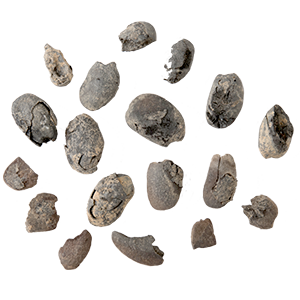 Fragments of burnt seeds are all that remain of the American persimmon trees that once shaded the fields of George Washington’s Mount Vernon estate. Yet these tiny relics still tell a powerful story about the persimmon fruit’s unique position on Washington’s plantation:
they were eaten by both the enslavers and the enslaved.
Fragments of burnt seeds are all that remain of the American persimmon trees that once shaded the fields of George Washington’s Mount Vernon estate. Yet these tiny relics still tell a powerful story about the persimmon fruit’s unique position on Washington’s plantation:
they were eaten by both the enslavers and the enslaved.
The fruits from an American persimmon tree, also known as Diospyros virginiana, have become legendary for their utter inedibility before they’ve endured a hearty frost, which transforms them overnight into a lusciously juicy, saccharine fruit. Mature persimmons contain somewhere between six and eight tough, bitter seeds, and before the fruits can be eaten, each seed must be removed and either discarded or roasted and ground (in the latter case making them into a coffee substitute popular in the early modern period). After the ripe persimmons were de-seeded, they lent themselves to a wide variety of food products including breads, beers, jams, and cakes. In the eighteenth century, persimmons were even considered an important herbal remedy. While persimmon tree bark could be brewed into a tea rich in vitamin C, the fruits were thought to help alleviate ailments ranging from fevers to syphilis.
In 1990, archaeologists first discovered the telling remains of several charred persimmon seeds at Mount Vernon’s South Grove Midden, a trash dump used by the Washington family before the American Revolution, suggesting that these fruits contributed to the family’s diet. In addition to their presence in the estate’s kitchens, Washington chronicled several years of experiments where he added persimmons to the whiskey and brandy that he made in his home distillery. During the Revolution, he left his cousin, Lund Washington, in charge of Mount Vernon. In 1778, Lund wrote to the general praising the exquisite taste of persimmon beer. Although there isn’t any direct evidence that George Washington tried the beer himself, this does establish that the beverage made an appearance in his household.
Around the same time as the South Grove Midden discoveries, archaeologists began excavations inside a small cellar measuring roughly six by six feet, where the enslaved people living at Mount Vernon’s House for Families deposited most of their refuse. During Washington’s lifetime, roughly 71 enslaved people lived there. Nearly all of them were skilled workers, such as blacksmiths, cooks, and butlers of the estate. It was here that archaeologists found the burnt persimmon seeds.
The seeds made up over a quarter of the total plant remains found in the cellar, indicating that the fruits may have comprised a large portion of the enslaved people’s diets. It’s likely that the enslaved population at Mount Vernon routinely foraged for food to supplement Washington’s meager portions of cornmeal and dried fish. Of the available options, the late-ripening persimmons were probably very desirable, offering a stable source of nutrients during bleak winter days and nights. As long as the fruits were kept cold and away from the light, they didn’t rot or spoil for months at a time. There are even records of them lasting well into March and April.
Of the variety of products that enslaved people made out of persimmons, beer is said to have been one of the most common, meaning that the fruits themselves were likely not the only persimmon product that appeared on the tables of both the enslavers and the enslaved at Mount Vernon. The beer was made by mashing or drying the persimmons into a bread or fruit cake, boiling them in a pot of water, and then allowing them to ferment for several weeks. In recent years, the culinary historian Michael Twitty has been working to re-incorporate the persimmon beer of his ancestors into modern cuisine, a tradition that draws from a robust collection of recipes, a selection which have been included below.
Image: 10 complete and 15 fragments of burnt persimmon seeds. 18th century. Object 1881301. Courtesy of Mount Vernon Ladies’ Association.
Selected Recipes
“Percimon Beer”
By Jane Bolling, a descendant of Pocahontas and a member of Thomas Jefferson’s extended family, who wrote this recipe in the cookbook she created from 1739–1743
“Take a tub with a fals bottom, and fill it up, with percimmons, and warm water, mas’d together Just thin enough to drop like Molasses, it will be two or three days a — dropping then put some of it into water, with hops according to the strength you — woall have it, and boile it well, then work it with yest.”
“Persimmon Beer”
By Millie Evans, an enslaved woman from Arkansas who recounted the recipe below as part of her 1936 interview for the Federal Writers’ Project
“Gather your persimmons, wash and put in a keg, cover well with water and add about two cups of meal to it and let sour about three days. That makes a nice drink. Boil persimmons just as you do prunes now day and they will answer for the same purpose.”
“Persimmon Bread”
Relayed by Duhamel du Monceau, a French botanist who in 1755 printed the following recipe for making persimmon bread, consumed by various Native American groups in the early modern period
“…one mashes the fruit through a strong sieve which separates the flesh from the skin and seeds: the flesh being reduced by boiling to a thick paste and then makes long bread loaves of a foot and a half in length, a foot wide and as thick as a finger. Then the bread is left out in the sun to dry or it can be cooked on a grill over a fire. These galettes have the best taste when left out in the sun to dry.”
 This article was written by Lauren Dorsey. For more information about her work and her other contributions to The Kitchen in the Cabinet click here.
This article was written by Lauren Dorsey. For more information about her work and her other contributions to The Kitchen in the Cabinet click here.
References
Adams, Michelle Medlock. The Perfect Persimmon: History, Recipes, and More. Bloomington: Indiana University Press, 2020.
Bolling, Jane. “Manuscript Cookbook : Jane Bolling Randolph and Jane Randolph Walke Cookbook.” https://www.manuscriptcookbookssurvey.org/collection/Detail/manuscripts/1306.
Briand, C.H. “The Common Persimmon (Diospyros virginiana L.): The History of an Underutilized Fruit Tree (16th–19th Centuries).” Huntia 12 no. 1 (2005): 19.
Covey, Herbert C. and Dwight Eisnach. What the Slaves Ate: Recollections of African American Foods and Foodways from the Slave Narratives. Santa Barbara, CA: ABC-CLIO, 2009.
DeWitt, Dave. The Founding Foodies: How Washington, Jefferson, and Franklin Revolutionized American Cuisine. Naperville, IL: Sourcebooks, Inc., 2010.
“The House for Families.” Mount Vernon. http://www.mountvernon.org/preservation/archaeology/the-house-for-families/.
“Persimmon (Diospyros virginiana) Seed.” Mount Vernon. https://www.mountvernon.org/preservation/archaeology/archaeology-online/object/1691403.
“Persimmon Seeds, 10 Complete, 15 Fragments.” Mount Vernon. https://www.mountvernon.org/preservation/archaeology/archaeology-online/object/1881301.
Porcher, Francis Peyre. Resources of the Southern Fields and Forests, Medical, Economical, and Agricultural: Being Also a Medical Botany of the Confederate States; with Practical Information on the Useful Properties of the Trees, Plants and Shrubs. Charleston: Steam-power Press of Evans & Cogswell, 1863.
Shick, Laura A. “An Analysis of Archaeobotanical Evidence from the House for Families Slave Quarter, Mount Vernon Plantation, Virginia.” Master of Arts Thesis, American University, 2004.
Smith, William B. “The Persimmon Tree—Diosphyros Virginiana.” The Farmers’ Register: A Monthly Publication Devoted to the Improvement of the Practice, and Support of the Interests of Agriculture 5, no. 10 (1838): 596.
Thompson, Mary V. “The Only Unavoidable Subject of Regret”: George Washington, Slavery, and the Enslaved Community at Mount Vernon. Charlottesville: University of Virginia Press, 2019.
Tilton, Robert S. Pocahontas: The Evolution of an American Narrative. Cambridge: Cambridge University Press, 1994.
Troop, James. The American Persimmon. Purdue University Agricultural Experiment Station, 1896.
Twitty, Michael. The Cooking Gene: A Journey Through African American Culinary History in the Old South. New York: HarperCollins, 2017.
Washington, Lund to George Washington. March 4, 1778. Manuscript, A-283, Mount Vernon Ladies’ Association.
Work Projects Administration. The Voices From The Past: Hundreds of Testimonies by Former Slaves In One Volume. Madison & Adams Press, 2017.